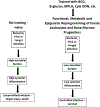Innate Immune Memory and the Host Response to Infection
- PMID: 35115374
- PMCID: PMC8982914
- DOI: 10.4049/jimmunol.2101058
Innate Immune Memory and the Host Response to Infection
Abstract
Unlike the adaptive immune system, the innate immune system has classically been characterized as being devoid of memory functions. However, recent research shows that innate myeloid and lymphoid cells have the ability to retain memory of prior pathogen exposure and become primed to elicit a robust, broad-spectrum response to subsequent infection. This phenomenon has been termed innate immune memory or trained immunity. Innate immune memory is induced via activation of pattern recognition receptors and the actions of cytokines on hematopoietic progenitors and stem cells in bone marrow and innate leukocytes in the periphery. The trained phenotype is induced and sustained via epigenetic modifications that reprogram transcriptional patterns and metabolism. These modifications augment antimicrobial functions, such as leukocyte expansion, chemotaxis, phagocytosis, and microbial killing, to facilitate an augmented host response to infection. Alternatively, innate immune memory may contribute to the pathogenesis of chronic diseases, such as atherosclerosis and Alzheimer's disease.
Copyright © 2022 by The American Association of Immunologists, Inc.
Figures


References
-
- Kurtz J 2004. Memory in the innate and adaptive immune systems. Microbes Infect 6: 1410–1417. - PubMed
-
- Bonilla FA, and Oettgen HC. 2010. Adaptive immunity. J Allergy Clin Immunol 125: S33–40. - PubMed
-
- Litman GW, Anderson MK, and Rast JP. 1999. Evolution of antigen binding receptors. Annu Rev Immunol 17: 109–147. - PubMed
-
- Yanagi Y, Caccia N, Kronenberg M, Chin B, Roder J, Rohel D, Kiyohara T, Lauzon R, Toyonaga B, Rosenthal K, and et al. 1985. Gene rearrangement in cells with natural killer activity and expression of the beta-chain of the T-cell antigen receptor. Nature 314: 631–633. - PubMed
Publication types
MeSH terms
Substances
Grants and funding
LinkOut - more resources
Full Text Sources
Medical

